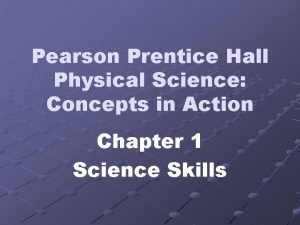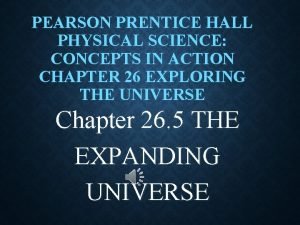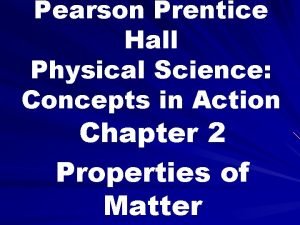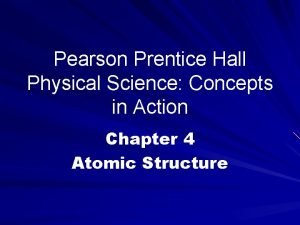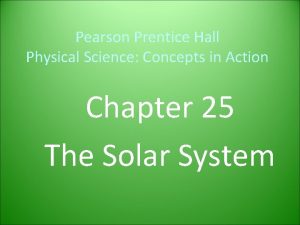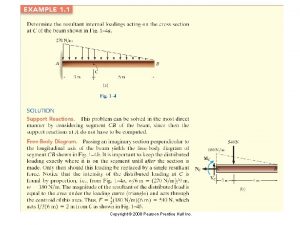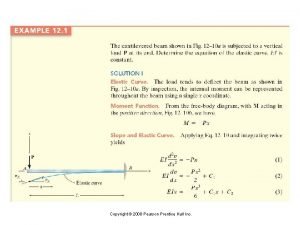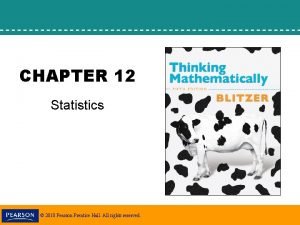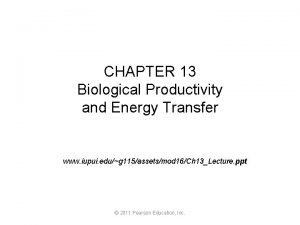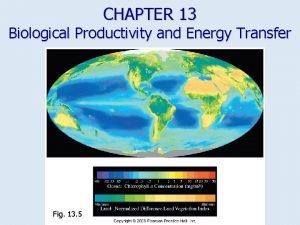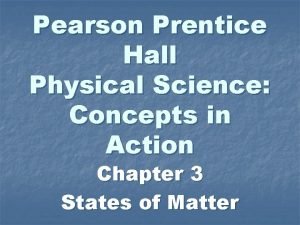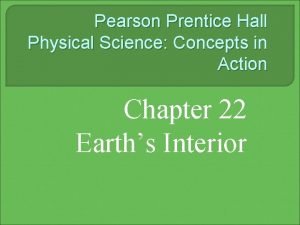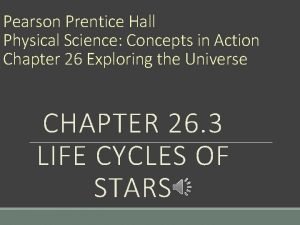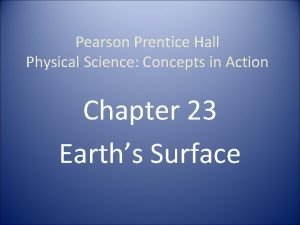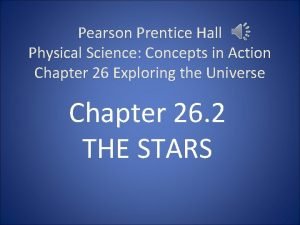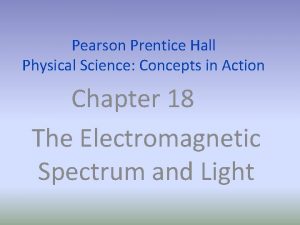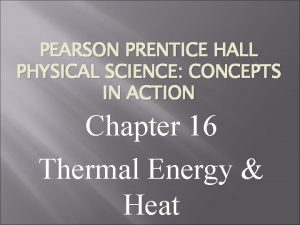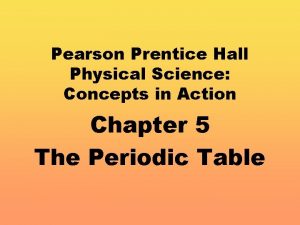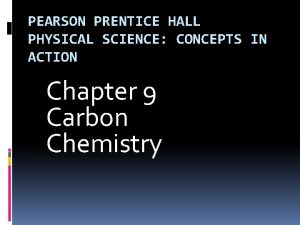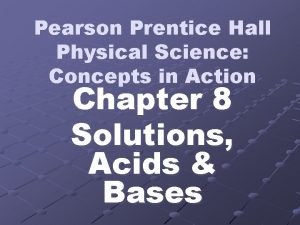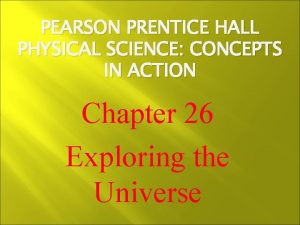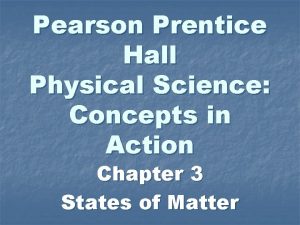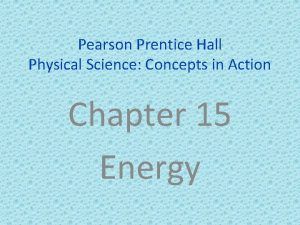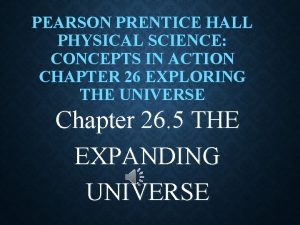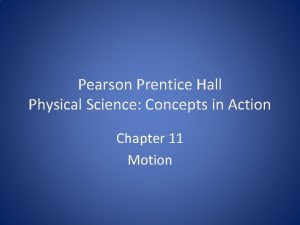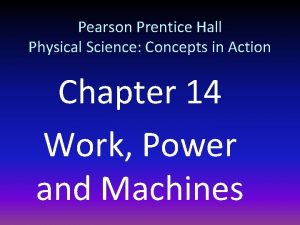Pearson Prentice Hall Physical Science Concepts in Action





















- Slides: 21

Pearson Prentice Hall Physical Science: Concepts in Action Chapter 4 Atomic Structure

4. 1 Studying Atoms Objectives: 1. Explain Dalton’s atomic theory 2. Explain the contributions of Thomson and Rutherford

Democritus (4 th century B. C) said the universe was made of invisible units called atoms In 1808, an Englishman named John Dalton proposed a theory: 1. every element is made of tiny unique particles called atoms that cannot be subdivided 2. atoms of the same element have the same mass & atoms of different elements have different masses 3. compounds contain atoms of more than one element 4. in any particular compound, atoms of different elements always combine in the same way

Thomson & Rutherford Q: What did Dalton notice that all compounds have in common? A: Compounds contain atoms of more than one element JJ Thomson (1856 -1940) used a sealed tube of gas to show that particles are charged

In Thomson’s experiment, the particles repelled the negative plate and were attracted to the positive plate Q: What was the charge on the particles in the beam of the gas? Thomson’s experiments provided the first evidence that atoms are made of even smaller particles

Q: How do objects of the same charge behave when they come close to one another? Thomson developed the “plum pudding” model of the atom His model suggested that negative charges were evenly scattered throughout an atom filled with a positively charged mass of matter

Ernest Rutherford (1871 -1937) discovered fast moving particles in uranium that he called alpha particles Uranium is a radioactive substance He used a zinc sulfide screen, gold foil and alpha particles to produce a very famous experiment in which he showed that the positive charges are not evenly dispersed throughout the atom

Rutherford concluded that atoms must have a concentrated central core Definition: a nucleus is a dense, positively charged mass located in the center of the atom According to Rutherford’s model, all of an atom’s positive charge is concentrated in its nucleus Today, much of an atom consists of empty space outside the positively charged nucleus

4. 2 The Structure of an Atom Objectives: 1. Describe three subatomic particles 2. Compare protons, electrons and neutrons in terms of physical properties 3. Explain how atoms of one element are different from atoms of other elements 4. Describe the difference between 2 isotopes of the same element

Three Subatomic Particles Protons, neutrons & electrons are subatomic particles Definition: a proton is a positively charged subatomic particle that is found in the nucleus of an atom Definition: an electron is a negatively charged subatomic particle found in the space OUTSIDE THE NUCLEUS (ORBITALS) Definition: a neutron is a neutral subatomic particle found in the nucleus of an atom

Comparing Protons, Neutrons & Electrons Protons, neutrons and electrons can be distinguished by mass, charge & location in an atom The mass of a neutron is almost exactly equal to the mass of a proton Electrons are nearly 2, 000 times less massive than either a proton or a neutron

Isotopes Definition: isotopes are atoms of the same element that have different numbers of neutrons and different mass numbers Isotopes: element has same atomic number, same # protons, different # neutrons, different mass # Q: Why do isotopes have different mass numbers for the same element? A: Because they have different numbers of neutrons

The mass of an electron is insignificant Thomson’s experiment with the gas tube detected electrons Rutherford discovered the positive central core The mass of each proton or neutron equals one atomic mass unit (amu) Q: What is the charge of a proton? (neutron? electron? ) Q: Where is the proton located in an atom? (neutron? electron? )

Atoms of Different Elements Atoms of any given element ALWAYS have the same number of PROTONS Definition: atomic number of an element equals the number of protons Atoms of different elements ALWAYS have different numbers of PROTONS The number of PROTONS determines which element you have

Definition: mass number of an atom is the sum of the protons plus the neutrons Neutrons + Protons = Mass # Q: Why aren’t electrons considered in the mass number of an atom? # neutrons = mass # - atomic # Q: What subatomic particle could be substituted for atomic number? Q: What 2 values represent mass#?

4. 3 Modern Atomic Theory Objectives: 1. Explain what can happen when atoms gain or lose energy 2. Explain the model that scientists use to describe how electrons behave in atoms 3. Describe the most stable configuration of electrons in an atom

Losing and Gaining Energy Since the time of Democritus & Dalton the model of the atom has been revised In 1913, Niels Bohr theorized that atoms move in set paths around the nucleus like planets orbiting the sun The electron path is an electron’s energy level Energy level: any of the possible energies an electron may have in an atom

Electrons in atoms must gain energy to move to a higher energy level or lose energy to move to a lower energy level The amount of energy gained (absorbed) to go higher or energy lost (released) can be measured Each element has its own unique set of energy levels The element itself determines the amount of energy gained or lost Bohr’s model does not explain all chemical observations

How Electrons Behave in Atoms Definition: an electron cloud is a visual model of the most likely locations for electrons in an atom Scientists use the electron cloud model to describe the possible locations of electrons around the nucleus Instead of set paths like orbits, electrons are found in orbitals which have unique shapes

An electron cloud is a good approximation of how electrons behave in their orbitals Definition: an orbital is a region of space around the nucleus of an atom where there is a high probability of finding an electron The level with the least energy has only one orbital Higher energy levels have more than one orbital

Electron Configurations Definition: an electron configuration is the arrangement of electrons in the orbitals of an atom The most stable configuration is the one in which the electrons are in orbitals with the lowest possible energies Definition: the ground state is when all electrons in an atom have the lowest possible energies Definition: excited state is when an electron is in an orbital with higher energy & less stability
 Prentice hall physical science: concepts in action
Prentice hall physical science: concepts in action Pearson education inc publishing as pearson prentice hall
Pearson education inc publishing as pearson prentice hall 2011 pearson education inc
2011 pearson education inc Pearson education inc publishing as pearson prentice hall
Pearson education inc publishing as pearson prentice hall Pearson 2012
Pearson 2012 2008 pearson prentice hall inc
2008 pearson prentice hall inc Bacground
Bacground Pearson physical science concepts in action
Pearson physical science concepts in action Pearson physical science concepts in action
Pearson physical science concepts in action Kuiper belt def
Kuiper belt def Prentice hall inc
Prentice hall inc 2008 pearson prentice hall inc
2008 pearson prentice hall inc Copyright 2005 pearson prentice hall inc
Copyright 2005 pearson prentice hall inc Pearson prentice hall
Pearson prentice hall Pearson prentice hall
Pearson prentice hall Pearson prentice hall
Pearson prentice hall 2005 pearson prentice hall inc
2005 pearson prentice hall inc Arthropods common name
Arthropods common name Pearson education inc. publishing as prentice hall
Pearson education inc. publishing as prentice hall Pearson education inc. 2012
Pearson education inc. 2012 Pearson education inc. publishing as prentice hall
Pearson education inc. publishing as prentice hall Pearson education inc. publishing as prentice hall
Pearson education inc. publishing as prentice hall
